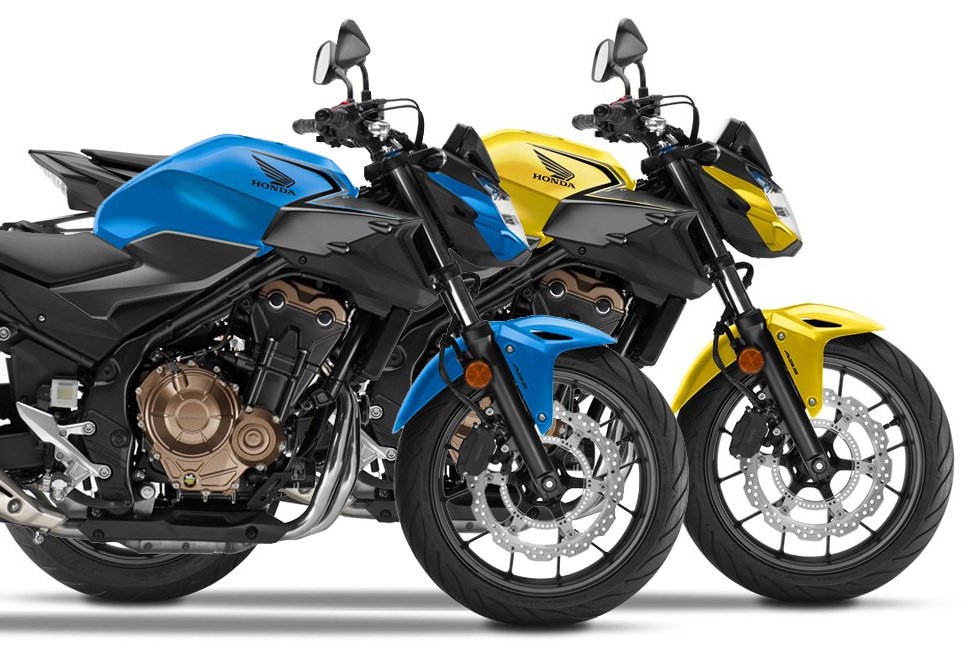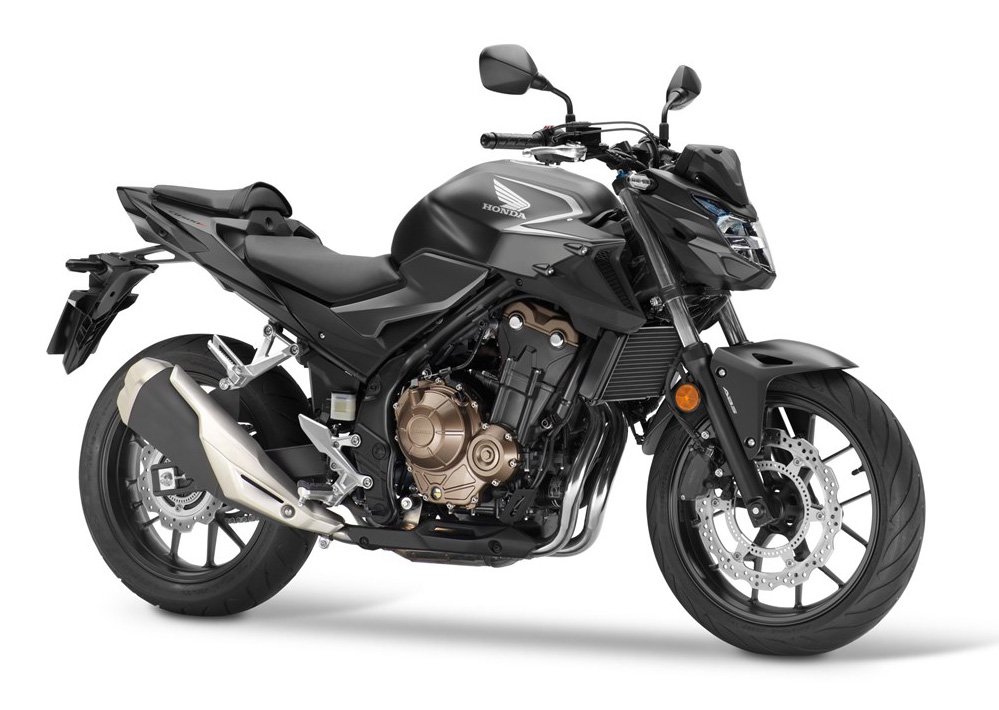The naked CB500F – originally launched in 2013 alongside the adventure-styled CB500X and fully-faired CBR500R – has proved that one of Honda’s tried-and-trusted formulas for building popular motorcycles has lost none of its relevance.
That formula? An entertaining twin-cylinder engine wrapped in a simple, lightweight, sporty chassis, which is as much fun for an experienced rider as it is for those still building their riding career. And while a 35kW peak power output makes it suitable for A2 licence holders, the CB500F offers so much more than ‘entry level’ performance.
While its compact dimensions and welcoming manners make it an easy machine to manage, ride and learn on, those same attributes also make it a genuine pleasure for those – whether stepping up from a 125 or coming down from a bigger machine – who want to explore just what it can do at the weekend. Sensible running costs, whatever the situation, add strongly to the appeal.
In 2019, the CB500F was redrawn with uncompromising lines that elevated its technical and mechanical aspects, and a host of upgrades that enhanced the riding experience even more. 2020 sees the introduction of updated graphics, two new striking colours and EURO5 homologation for one of Honda’s most popular machines.
Model Overview
The CB500F’s 35kW engine is A2 licence-compatible and benefits from the 2019 upgrades to the inlet, exhaust and valve timing, which added 4% more power and torque between 3-7,000rpm compared to the previous model, and were accompanied by an enhanced exhaust note and a new assist/slipper clutch.
LCD instruments include a Shift Up and Gear Position indicator, and all the lighting is LED. While both engine and chassis are unchanged for the EURO5-homologated 2021 year model, two bright new colours freshen up the appeal.
Styling & Chassis
- Aggressively-styled bodywork
- Tapered handlebars for excellent control and feel
- LCD instrument display, with Gear Position and Shift Up indicators
- Full LED lighting
- Two new colours for 2020.
For its 2019 evolution, the CB500F’s naked faired form evolved front to rear, exuding a new-found aggression. Led by the penetrating headlight design, the machine’s stance is low-set and ready for action; the side shrouds interlock with the fuel tank and fully emphasize the engine, while the side covers and seat unit continue the theme of muscular angularity.
Tapered handlebars give intuitive feel and leverage. LCD instruments feature a Gear Position and Shift Up indicator; this is set to a default 8,750rpm but can be adjusted in 250rpm increments between 5-8,750rpm
The 35mm diameter steel diamond-tube mainframe is unchanged for 2020. It’s light and strong, with a tuned degree of yield that gives plenty of feedback to the rider as road surfaces change. The shape and position of the engine mounts, plus the frame’s rigidity balance also reduces vibration.
Wheelbase is 1410mm and rake and trail are set at 25.5°/102mm, giving nimble, yet confidence-inspiring steering. Mass centralisation, with the engine in close proximity to the swingarm pivot point, delivers turning agility and optimum front/rear weight distribution ensures stability. Kerb weight is 189kg.
Seat height is low at 785mm, making the CB500F very easy to manage and its neutral riding position comfortably accommodates riders of any height. Overall dimensions are 2080mm x 790mm x 1060mm, with 145mm ground clearance. The fuel tank holds 17.1L including reserve, and, combined with the engine’s excellent 28.6km/litre fuel economy, gives a range of 480km (over 260 miles).
The 41mm preload-adjustable telescopic front fork, with 120mm stroke, delivers a compliant yet controlled ride and gives great feel for front tyre grip. A single-tube rear shock absorber (as found on larger capacity sports bikes) with a large-diameter piston, ensures excellent suspension response and temperature management. It has 9-stage spring preload adjustment and works through a rigid box-section steel swingarm, which features pressed steel chain adjustment end-pieces. Final drive is via sealed 520 chain.
Lightweight, 17-inch cast aluminium wheels employ hollow cross-section Y-shaped spokes. Front wheel width is 3.5inch with a 120/70-ZR17 tyre, the rear 4.5inch with a 160/60-ZR17 tyre. A single front 320mm wavy disc and two-piston brake caliper is matched to a 240mm rear disc and single-piston caliper. ABS is fitted as standard.
The CB500F will be available in the following colour options: Grand Prix Red; Matt Gunpowder Black Metallic; NEW colours – Candy Caribbean Blue Sea and Candy Moon Glow Yellow.

Engine
- Lively twin-cylinder power plant’s internal architecture mirrors that of the 2019 CBR1000RR Fireblade
·Usable power and torque across the range- Sportier sound from the dual-exit muffler
- Assist/slipper clutch eases upshifts and manages downshifts
- Now Homologated for EURO5
The CB500F’s A2-licence friendly, 8-valve liquid-cooled parallel twin-cylinder layout offers a well-proportioned balance of physical size and willing, enjoyable power output, with an energetic, high-revving character and zappy top end.
Already strong off the bottom, the 2019 engine upgrades saw faster acceleration through a boost in low-to-mid-range power and torque in the 3-7,000rpm range; with a 4% improvement coming via altered valve timing – with ‘close’ timing accelerated by 5° – and lift increased by 0.3mm to 7.8mm.
Feeding the PGM-FI fuel injection is a more-or-less straight shot of airflow through the airbox and throttle bodies – the 2019 upgrade saw the battery re-positioned further away from the rear of the airbox intake duct to allow greater airflow. The exhaust muffler features dual exit pipes, giving a sporty sounding edge to each pulse. Peak power of 35kW arrives at 8,500rpm, with 43Nm torque delivered at 7,000rpm.
Bore and stroke is set at 67mm x 66.8mm and compression ratio is 10.7:1; the crankshaft pins are phased at 180° and a primary couple-balancer sits behind the cylinders, close to the bike’s centre of gravity. The primary and balancer gears use scissor gears, reducing noise. The crank counterweight is specifically shaped for couple-balance and its light weight allows the engine to spin freely, with reduced inertia.
Acting as a stressed member, the engine complements the frame’s rigidity with four frame hangers on the cylinder head. Internally the cylinder head uses roller rocker arms; shim-type valve adjustment allows them to be light, for lower valve-spring load and reduced friction.
A silent (SV Chain) cam chain has the surface of its pins treated with Vanadium, reducing friction with increased protection against wear. Inlet valve diameter is 26.0mm with exhaust valve diameter of 21.5mm.
The piston shape is based upon those used in the 2019 CBR1000RR Fireblade to reduce piston ‘noise’ at high rpm. Friction is reduced by striations on the piston skirt (a finish that increases surface area, introducing gaps in which oil can flow for better lubrication). As with the CBR1000RR, an AB1 salt bath process, used after isonite nitriding, forms a protective oxidisation membrane.
The ‘triangle’ proportion of crankshaft, main shaft and countershaft is very similar to that of Honda’s four-cylinder RR engines and much of the internal structure and engineering is taken directly from the 2019 CBR1000RR.
The crankcase uses centrifugally cast thin-walled sleeves; their internal design reduces the ‘pumping’ losses that can occur with a 180° phased firing order. The oil pump features improved aeration performance, with reduced friction; a deep sump reduces oil movement under hard cornering and braking. Oil capacity is 3.2L.
The CB500F’s six-speed gearbox is very close to that of its RR cousin and uses the same gear change arm structure and link mechanism. Introduced in 2019, an assist/slipper clutch enables lighter upshifts and smooths out any hard downshifts.
The CB500F, like its 500cc stablemates, is homologated for EURO5, which from January 1st 2020,introduced significantly stricter engine emissions standards compared to EURO4. These requirements include substantial reductions in permitted carbon monoxide emissions, an over 40% decrease in total hydrocarbon emissions, tougher misfire detection and the introduction of a particulate matter limit.
#honda2021 #hondacb500f #hondacbf2021 #motogusto

